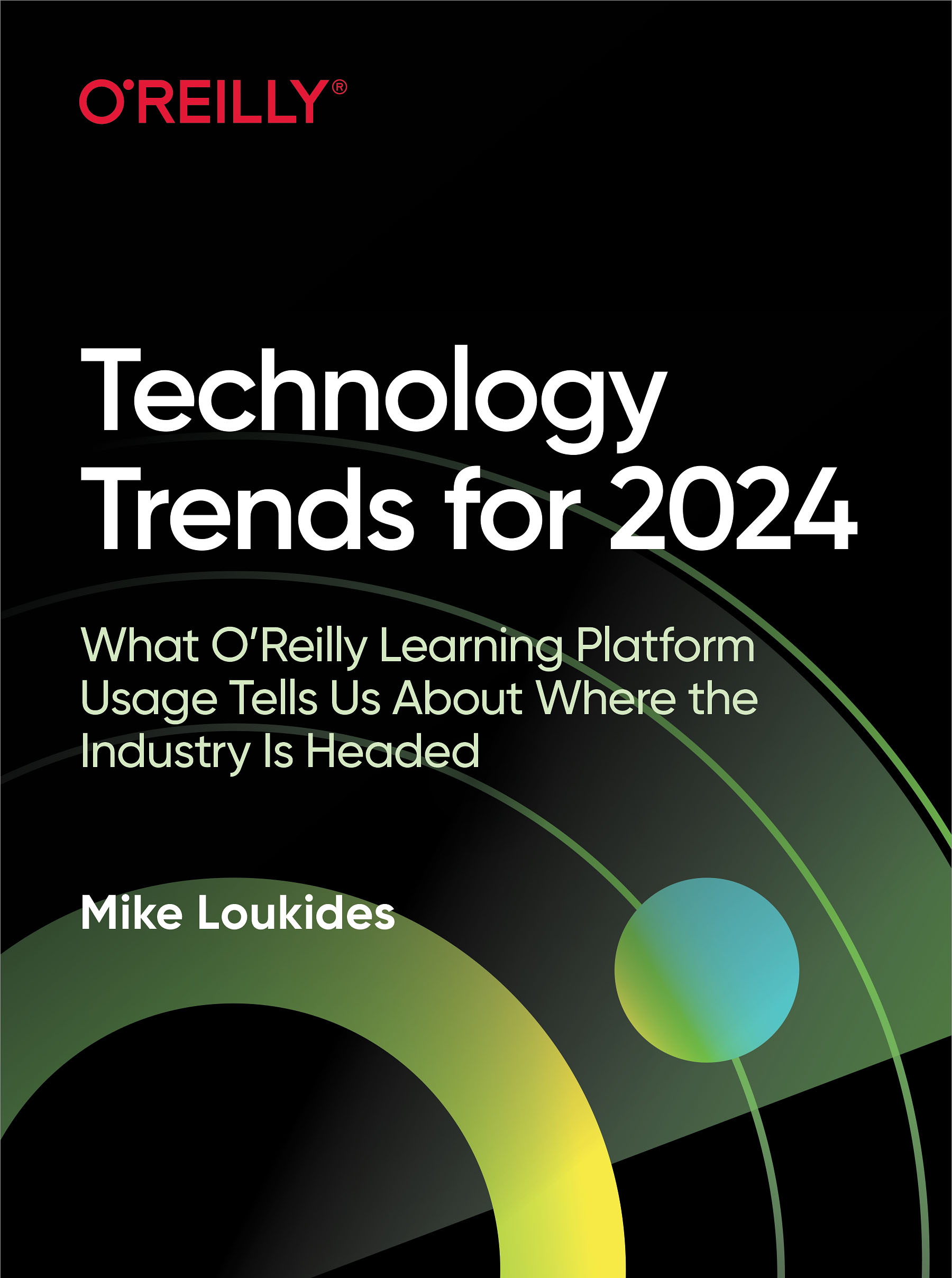
This has been an odd 12 months. Whereas we like to speak about how briskly expertise strikes, web time, and all that, in actuality the final main new concept in software program structure was microservices, which dates to roughly 2015. Earlier than that, cloud computing itself took off in roughly 2010 (AWS was based in 2006); and Agile goes again to 2000 (the Agile Manifesto dates again to 2001, Excessive Programming to 1999). The online is over 30 years outdated; the Netscape browser appeared in 1994, and it wasn’t the primary. We expect the trade has been in fixed upheaval, however there have been comparatively few disruptions: one each 5 years, if that.
2023 was a type of uncommon disruptive years. ChatGPT modified the trade, if not the world. We’re skeptical about issues like job displacement, not less than in expertise. However AI goes to carry adjustments to virtually each side of the software program trade. What’s going to these adjustments be? We don’t know but; we’re nonetheless at first of the story. On this report about how persons are utilizing O’Reilly’s studying platform, we’ll see how patterns are starting to shift.
Just some notes on methodology: This report is predicated on O’Reilly’s inside “Models Seen” metric. Models Seen measures the precise utilization of content material on our platform. The info used on this report covers January by November in 2022 and 2023. Every graph is scaled in order that the subject with the best utilization is 1. Due to this fact, the graphs can’t be in contrast instantly to one another.
Do not forget that these “items” are “seen” by our customers, who’re largely skilled software program builders and programmers. They aren’t essentially following the newest tendencies. They’re fixing real-world issues for his or her employers. They usually’re choosing up the talents they should advance of their present positions or to get new ones. We don’t wish to low cost those that use our platform to stand up to hurry on the newest scorching expertise: that’s how the trade strikes ahead. However to know utilization patterns, it’s essential to comprehend that each firm has its personal expertise stacks, and that these stacks change slowly. Firms aren’t going to throw out 20 years’ funding in PHP to allow them to undertake the newest common React framework, which can most likely be displaced by one other common framework subsequent 12 months.
Software program Growth
Many of the subjects that fall beneath software program growth declined in 2023. What does this imply? Programmers are nonetheless writing software program; our lives are more and more mediated by software program, and that isn’t going to alter.
Software program builders are answerable for designing and constructing greater and extra advanced initiatives than ever. That’s one development that gained’t change: complexity is at all times “up and to the correct.” Generative AI is the wild card: Will it assist builders to handle complexity? Or will it add complexity all its personal? It’s tempting to take a look at AI as a fast repair. Who needs to find out about coding practices once you’re letting GitHub Copilot write your code for you? Who needs to find out about design patterns or software program structure when some AI utility might ultimately do your high-level design? AI is writing low-level code now; as many as 92% of software program builders are utilizing it. Whether or not will probably be in a position to do high-level design is an open query—however as at all times, that query has two sides: “Will AI do our design work?” is much less attention-grabbing than “How will AI change the issues we wish to design?” And the actual query that can change our trade is “How can we design methods wherein generative AI and people collaborate successfully?”
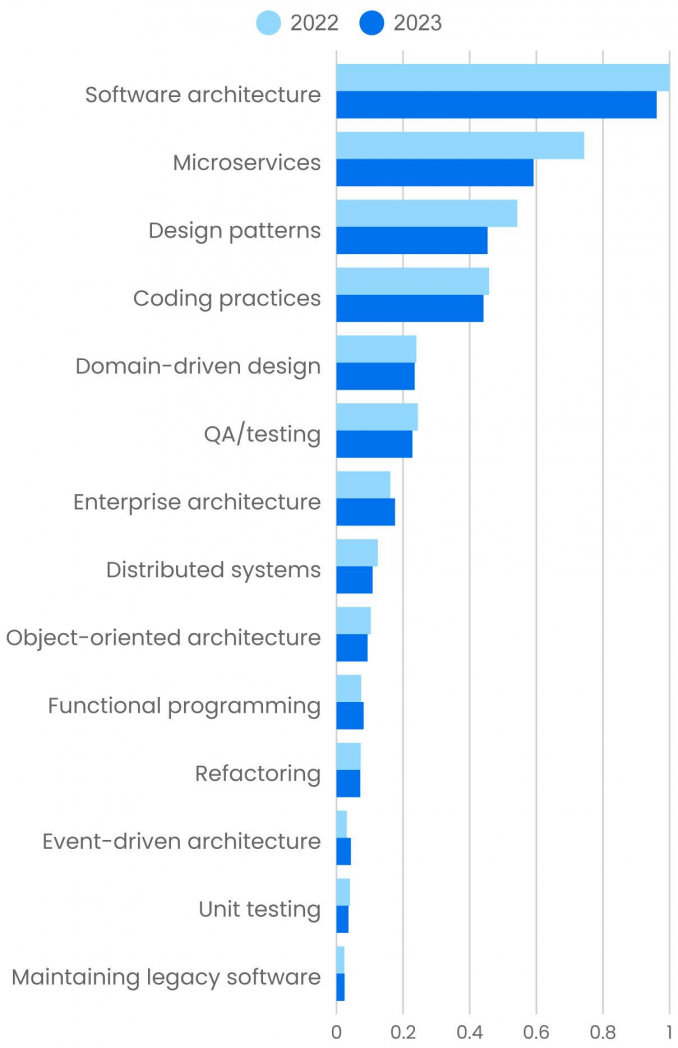
Whatever the solutions to those questions, people might want to perceive and specify what must be designed. Our information reveals that almost all subjects in software program structure and design are down year-over-year. However there are exceptions. Whereas software program structure is down 3.9% (a comparatively small decline), enterprise structure is up 8.9%. Area-driven design is especially helpful for understanding the conduct of advanced enterprise methods; it’s down, however solely 2.0%. Use of content material about event-driven structure is comparatively small, however it’s up 40%. That change is essential as a result of event-driven structure is a instrument for designing giant methods that need to ingest information from many alternative streams in actual time. Practical programming, which many builders see as a design paradigm that can assist remedy the issues of distributed methods, is up 9.8%. So the software program growth world is altering. It’s shifting towards distributed methods that handle giant flows of knowledge in actual time. Use of content material on subjects related to that shift is holding its personal or rising.
Microservices noticed a 20% drop. Many builders expressed frustration with microservices in the course of the 12 months and argued for a return to monoliths. That accounts for the sharp decline—and it’s truthful to say that many organizations are paying the value for shifting to microservices as a result of it was “the factor to do,” not as a result of they wanted the dimensions or flexibility that microservices can provide. From the beginning, microservice proponents have argued that one of the simplest ways to develop microservices is to start out with a monolith, then break the monolith into providers because it turns into mandatory. If applied poorly, microservices ship neither scale nor flexibility. Microservices aren’t excellent for brand new greenfield initiatives, until you’re completely positive that you just want them from the beginning—and even then, you need to suppose twice. It’s positively not a expertise to implement simply to observe the newest fad.
Software program builders run cold and warm on design patterns, which declined 16%. Why? It most likely relies on the wind or the part of the moon. Content material utilization about design patterns elevated 13% from 2021 to 2022, so this 12 months’s decline simply undoes final 12 months’s acquire. It’s potential that understanding patterns appears much less essential when AI is writing a whole lot of the code for you. It’s additionally potential that design patterns appear much less related when code is already largely written; most programmers keep present purposes relatively than develop new greenfield apps, and few texts about design patterns focus on the patterns which can be embedded in legacy purposes. However each methods of considering miss the purpose. Design patterns are widespread options to widespread issues which have been noticed in observe. Understanding design patterns retains you from reinventing wheels. Frameworks like React and Spring are essential as a result of they implement design patterns. Legacy purposes gained’t be improved by refactoring present code simply to make use of some sample, however design patterns are helpful for extending present software program and making it extra versatile. And, in fact, design patterns are utilized in legacy code—even code that was written earlier than the time period was coined! Patterns are found, not “invented”; once more, they’re widespread options to issues programmers have been fixing for the reason that starting of programming.
On the identical time, each time there’s a surge of curiosity in design patterns, there’s a corresponding surge in sample abuse: managers asking builders what number of patterns they used (as if sample depend have been a metric for good code), builders implementing FactoryFactoryFactory Factories, and the like. What goes round comes round, and the abuse of design patterns is a part of a suggestions loop that regulates the usage of design patterns.
Programming and Programming Languages
Many of the programming languages we observe confirmed declines in content material utilization. Earlier than discussing specifics, although, we have to have a look at normal tendencies. If 92% of programmers are utilizing generative AI to put in writing code and reply questions, then we’d definitely anticipate a drop in content material use. Which will or might not be advisable for profession growth, however it’s a actuality that companies constructed on coaching and studying need to acknowledge. However that isn’t the entire story both—and the larger story leaves us with extra questions than solutions.
Rachel Stephens supplies two fascinating items of the puzzle in a current article on the RedMonk weblog, however these items don’t match collectively precisely. First, she notes the decline in questions requested on Stack Overflow and states (moderately) that asking a nonjudgmental AI assistant may be a preferable manner for freshmen to get their questions answered. We agree; we at O’Reilly have constructed O’Reilly Solutions to supply that type of help (and are within the strategy of a significant improve that can make it much more helpful). However Stack Overflow reveals a broad peak in questions from 2014 to 2017, with a pointy decline afterward; the variety of questions in 2023 is barely 50% of the height, and the 20% decline from the January 2023 report back to the July report is just considerably sharper than the earlier drops. And there was no generative AI, no ChatGPT, again in 2017 when the decline started. Did generative AI play a job? It might be silly to say that it didn’t, however it might’t be the entire story.
Stephens factors to a different anomaly: GitHub pull requests declined roughly 25% from the second half of 2022 to the primary half of 2023. Why? Stephens guesses that there was elevated GitHub exercise in the course of the pandemic and that exercise has returned to regular now that we’ve (incorrectly) determined the pandemic is over. Our personal concept is that it’s a response to GPT fashions leaking proprietary code and abusing open supply licenses; that would trigger programmers to be cautious of public code repositories. However these are solely guesses. This transformation is seemingly not an error within the information. It may be a one-time anomaly, however nobody actually is aware of the trigger. One thing drove down programmer exercise on GitHub, and that’s inevitably part of the background to this 12 months’s information.
So, what does O’Reilly’s information say? Because it has been for a few years, Python is probably the most extensively used programming language on our platform. This 12 months, we didn’t see a rise; we noticed a really small (0.14%) decline. That’s noise; we gained’t insult your intelligence by claiming that “flat in a down market” can be a acquire. It’s definitely truthful to ask whether or not a language as common as Python has gathered all of the market share that it’s going to get. Once you’re on the high of the adoption curve, it’s tough to go any larger and far simpler to drop again. There are at all times new languages able to take a few of Python’s market share. Probably the most vital change within the Python ecosystem is Microsoft’s integration of Python into Excel spreadsheets, however it’s too early to anticipate that to have had an impact.
Use of content material about Java declined 14%, a major drop however not out of line with the drop in GitHub exercise. Like Python, Java is a mature language and should have nowhere to go however down. It has by no means been “nicely cherished”; when Java was first introduced, individuals walked out of the doorways of the convention room claiming that Java was lifeless earlier than you might even obtain the beta. (I used to be there.) Is it time to bop on Java’s grave? That dance has been occurring since 1995, and it hasn’t been proper but.
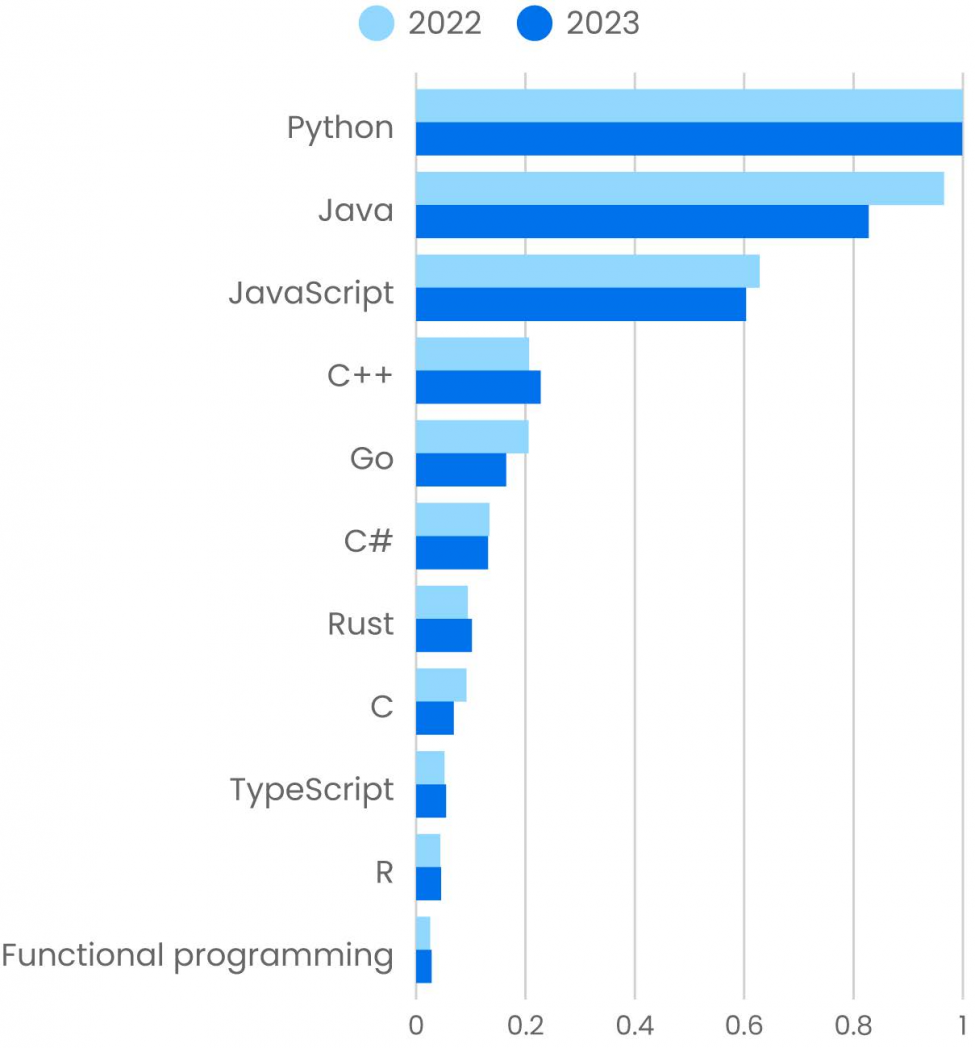
JavaScript additionally declined by 3.9%. It’s a small decline and possibly not significant. TypeScript, a model of JavaScript that provides static typing and kind annotations, gained 5.6%. It’s tempting to say that these cancel one another out, however that’s not appropriate. Utilization of TypeScript content material is roughly one-tenth the utilization of JavaScript content material. However it’s appropriate to say that curiosity in sort methods is rising amongst net builders. It’s additionally true that an growing variety of junior builders use JavaScript solely by a framework like React or Vue. Boot camps and different crash applications usually practice college students in “React,” with little consideration on the larger image. Builders skilled in applications like these might concentrate on JavaScript however might not consider themselves as JavaScript builders, and might not be trying to study extra concerning the language exterior of a slim, framework-defined context.
We see development in C++ (10%), which is stunning for an outdated, well-established language. (C++ first appeared in 1985.) At this level in C++’s historical past, we’d anticipate it to be a headache for individuals sustaining legacy code, not a language for beginning new initiatives. Why is it rising? Whereas C++ has lengthy been an essential language for sport growth, there are indicators that it’s breaking out into different areas. C++ is a perfect language for embedded methods, which frequently require software program that runs instantly on the processor (for instance, the software program that runs in a wise lightbulb or within the braking system of any trendy automobile). You aren’t going to make use of Python, Java, or JavaScript for these purposes. C++ can also be a superb language for quantity crunching (Python’s numeric libraries are written in C++), which is more and more essential as synthetic intelligence goes mainstream. It has additionally turn out to be the brand new “should have” language on résumés: figuring out C++ proves that you just’re robust, that you just’re a “critical” programmer. Job anxiousness exists—whether or not or not it’s merited is a distinct query—and in an atmosphere the place programmers are nervous about retaining their present jobs or trying ahead to discovering a brand new one, figuring out a tough however extensively used language can solely be an asset.
Use of content material about Rust additionally elevated from 2022 to 2023 (7.8%). Rust is a comparatively younger language that stresses reminiscence security and efficiency. Whereas Rust is taken into account tough to study, the concept reminiscence security is baked in makes it an essential various to languages like C++. Bugs in reminiscence administration are a major supply of vulnerabilities, as famous in NIST’s web page on “Safer Languages,” and Rust does job of implementing secure reminiscence utilization. It’s now utilized in working methods (Linux kernel parts), instrument growth, and even enterprise software program.
We additionally noticed 9.8% development in content material about practical programming. We didn’t see beneficial properties for any of the historic practical programming languages (Haskell, Erlang, Lisp, and Elixir) although; most noticed steep declines. Previously decade, most programming languages have added practical options. Newer languages like Rust and Go have had them from the beginning. And Java has steadily added options like closures in a sequence of updates. Now programmers will be as practical as they wish to be with out switching to a brand new language.
Lastly, there are some programming languages that we don’t but observe however that we’re watching with curiosity. Zig is an easy crucial language that’s designed to be reminiscence secure, like Rust, however comparatively simple to study. Mojo is a superset of Python that’s compiled, not interpreted. It’s designed for top efficiency, particularly for numerical operations. Mojo’s objective is to facilitate AI programming in a single language relatively than a mixture of Python and another language (usually C++) that’s used for performance-critical numerical code. The place are these languages going? Will probably be some years earlier than they attain the extent of Rust or Go, however they’re off to begin.
So what does all this inform us about coaching and ability growth? It’s simple to suppose that, with Copilot and different instruments to reply all of your questions, you don’t have to put as a lot effort into studying new applied sciences. All of us ask questions on Google or Stack Overflow, and now we’ve different locations to get solutions. Obligatory as that’s, the concept asking questions can change coaching is naive. In contrast to many who’re observing the affect of generative AI on programming, we imagine that it’s going to improve the hole between entry-level abilities and senior developer abilities. Being a senior developer—being a senior something—requires a type of fluency which you can’t get simply from asking questions. I’ll by no means be a fluent person of Python’s pandas library (which I used extensively to put in writing this report); I requested plenty of questions, and that has undoubtedly saved me time. However what occurs once I want to unravel the following drawback? The type of fluency that it’s essential have a look at an issue and perceive tips on how to remedy it doesn’t come from asking easy “How do I do that?” questions. Nor does it preclude asking plenty of “I forgot how this perform works” questions. That’s why we’ve constructed O’Reilly Solutions, an AI-driven service that finds options to questions utilizing content material from our platform. However experience does require creating the mental muscle that comes from grappling with issues and fixing them your self relatively than letting one thing else remedy them for you. (And that features forcing your self to recollect all of the messy syntax particulars.) Individuals who suppose generative AI is a shortcut to experience (and the job title and wage that experience deserves) are shortchanging themselves.
Synthetic Intelligence
In AI, there’s one story and just one story, and that’s the GPT household of fashions. Utilization of content material on these fashions exploded 3,600% up to now 12 months. That explosion is tied to the looks of ChatGPT in November 2022. However don’t make the error of considering that ChatGPT got here out of nowhere. GPT-3 created an enormous splash when it was launched in 2020 (full with a slipshod web-based interface). GPT-2 appeared in 2019, and the unique unnumbered GPT was even earlier. The true innovation in ChatGPT wasn’t the expertise itself (although the fashions behind it characterize a major breakthrough in AI efficiency); it was packaging the mannequin as a chatbot. That doesn’t imply that the GPT explosion wasn’t actual. Whereas our evaluation of search tendencies reveals that curiosity in ChatGPT has peaked amongst our platform’s customers, curiosity in pure language processing (NLP) confirmed a 195% improve—and from a a lot larger place to begin.1 That is smart, given the extra technical nature of our viewers. Software program builders might be constructing on high of the APIs for GPT and different language fashions and are probably much less fascinated about ChatGPT, the web-based chat service. Associated subjects generative fashions (900%) and Transformers (325%) additionally confirmed large beneficial properties. Immediate engineering, which didn’t exist in 2022, grew to become a major subject, with roughly the identical utilization as Transformers. So far as whole use, NLP is nearly twice GPT. Nevertheless you wish to learn the info, that is AI’s massive 12 months, largely as a result of GPT fashions and the thought of generative AI.
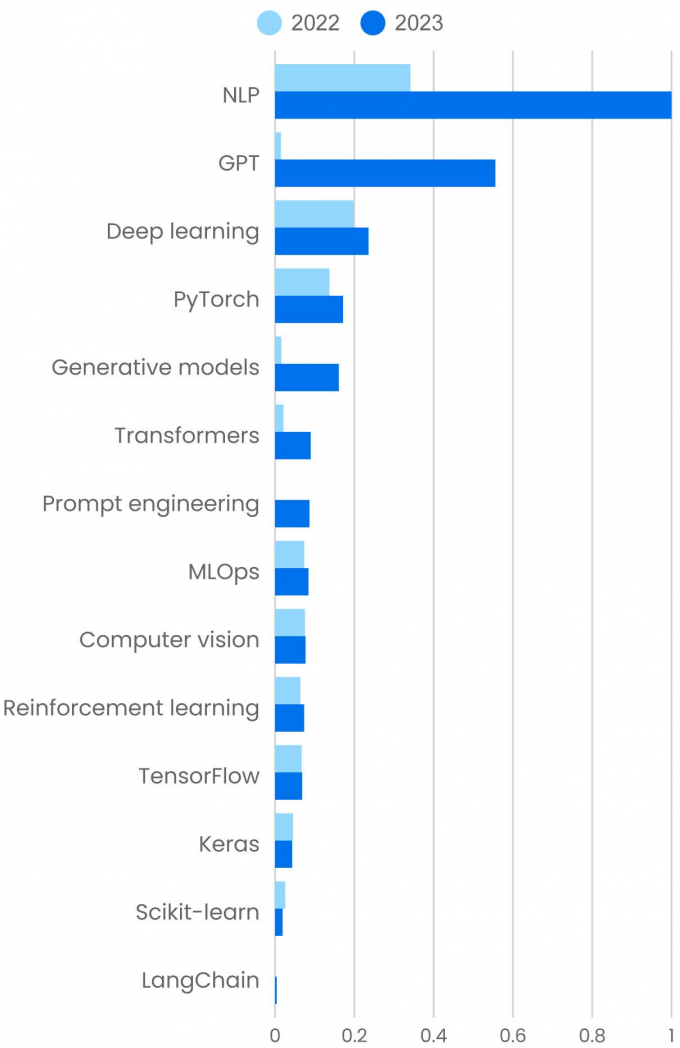
However don’t assume that the explosion of curiosity in generative AI meant that different features of AI have been standing nonetheless. Deep studying, the creation and utility of neural networks with many layers, is key to each side of contemporary AI. Utilization in deep studying content material grew 19% up to now 12 months. Reinforcement studying, wherein fashions are skilled by giving “rewards” for fixing issues, grew 15%. These beneficial properties solely look small compared to the triple- and quadruple-digit beneficial properties we’re seeing in pure language processing. PyTorch, the Python library that has come to dominate programming in machine studying and AI, grew 25%. In recent times, curiosity in PyTorch has been rising on the expense of TensorFlow, however TensorFlow confirmed a small acquire (1.4%), reversing (or not less than pausing) its decline. Curiosity in two older libraries, scikit-learn and Keras, declined: 25% for scikit-learn and 4.8% for Keras. Keras has largely been subsumed by TensorFlow, whereas scikit-learn hasn’t but included the capabilities that might make it platform for constructing generative AI. (An try and implement Transformers in scikit-learn seems to be underway at Hugging Face.)
We’ve lengthy stated that operations is the elephant within the room for machine studying and synthetic intelligence. Constructing fashions and creating purposes is difficult and enjoyable, however no expertise can mature if IT groups can’t deploy, monitor, and handle it. Curiosity in operations for machine studying (MLOps) grew 14% over the previous 12 months. That is stable, substantial development that solely seems small compared with subjects like generative AI. Once more, we’re nonetheless within the early phases—generative AI and enormous language fashions are solely beginning to attain manufacturing. If something, this improve most likely displays older purposes of AI. There’s a rising ecosystem of startups constructing instruments for deploying and monitoring language fashions, that are essentially totally different from conventional purposes. As firms deploy the purposes they’ve been constructing, MLOps will proceed to see stable development. (Extra on MLOps once we focus on operations beneath.)
LangChain is a framework for constructing generative AI purposes round teams of fashions and databases. It’s usually used to implement the retrieval-augmented era (RAG) sample, the place a person’s immediate is used to lookup related gadgets in a vector database; these gadgets are then mixed with the immediate, producing a brand new immediate that’s despatched to the language mannequin. There isn’t a lot content material about LangChain out there but, and it didn’t exist in 2022, however it’s clearly going to turn out to be a foundational expertise. Likewise, vector databases aren’t but in our information. We anticipate that to alter subsequent 12 months. They’re relatively specialised, so we anticipate utilization to be comparatively small, in contrast to merchandise like MySQL—however they are going to be crucial.
AI wasn’t dominated completely by the work of OpenAI; Meta’s LLaMA and Llama 2 additionally attracted a whole lot of consideration. The supply code for LLaMA was open supply, and its weights (parameters) have been simply out there to researchers. These weights rapidly leaked from “researchers” to most people, the place they jump-started the creation of smaller open supply fashions. These fashions are a lot smaller than behemoths like GPT-4. A lot of them can run on laptops, and so they’re proving excellent for smaller firms that don’t wish to depend on Microsoft, OpenAI, or Google to supply AI providers. (If you wish to run an open supply language mannequin in your laptop computer, attempt llamafile.) Whereas large “basis fashions” just like the GPT household gained’t disappear, in the long term open supply fashions like Alpaca and Mistral might show to be extra essential to software program builders.
It’s simple to suppose that generative AI is nearly software program growth. It isn’t; its affect extends to simply about each discipline. Our ChatGPT: Potentialities and Pitfalls Superstream was probably the most extensively attended occasion we’ve ever run. There have been over 28,000 registrations, with attendees and sponsors from industries as various as prescription drugs, logistics, and manufacturing. Attendees included small enterprise house owners, gross sales and advertising and marketing personnel, and C-suite executives, together with many programmers and engineers from totally different disciplines. We’ve additionally been operating programs centered on particular industries: Generative AI for Finance had over 2,000 registrations, and Generative AI for Authorities over 1,000. And greater than 1,000 individuals signed up for our Generative AI for Healthcare occasion.
Knowledge
In earlier years, we’d have advised the story of AI as a part of the story of knowledge. That’s nonetheless appropriate; with its heavy emphasis on arithmetic and statistics, AI is a pure outgrowth of knowledge science. However this 12 months, AI has turn out to be the famous person that will get high billing, whereas information is a supporting actor.
That doesn’t imply that information is unimportant. Removed from it. Each firm makes use of information: for planning, for making projections, for analyzing what’s taking place inside the enterprise and the markets they serve. So it’s not stunning that the second largest subject in information is Microsoft Energy BI, with a 36% improve since 2022. SQL Server additionally confirmed a 5.3% improve, and statistics toolbox R elevated by 4.8%.
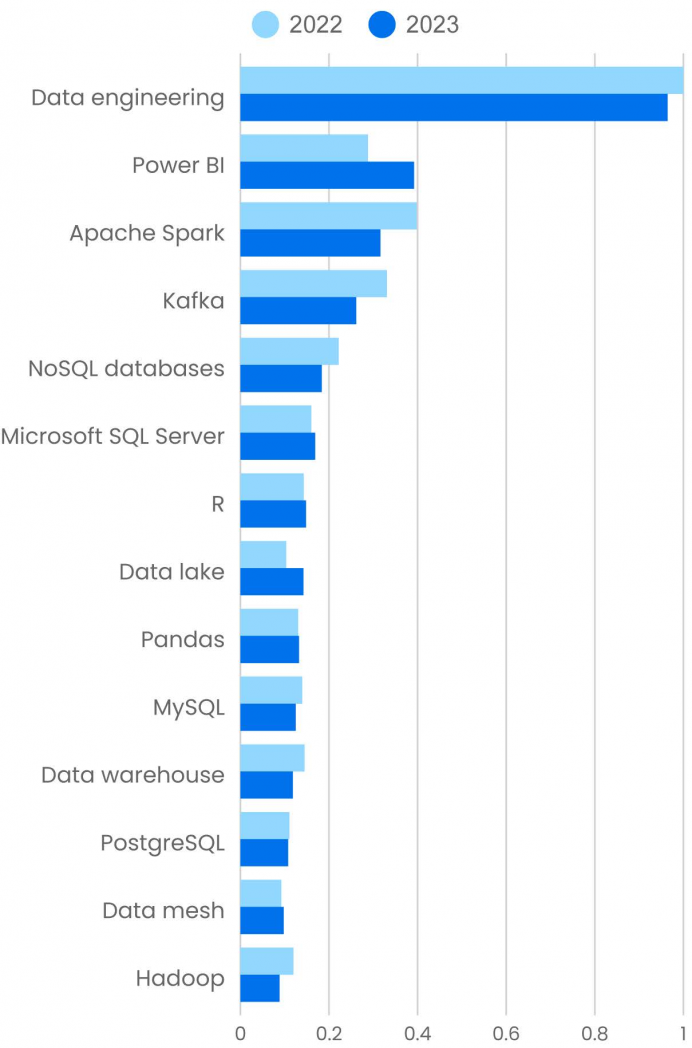
Knowledge engineering was by far probably the most closely used subject on this class; it confirmed a 3.6% decline, stabilizing after an enormous acquire from 2021 to 2022. Knowledge engineering offers with the issue of storing information at scale and delivering that information to purposes. It consists of shifting information to the cloud, constructing pipelines for buying information and getting information to utility software program (usually in close to actual time), resolving the problems which can be attributable to information siloed in several organizations, and extra. Two of a very powerful platforms for information engineering, Kafka and Spark, confirmed vital declines in 2023 (21% and 20%, respectively). Kafka and Spark have been workhorses for a few years, however they’re beginning to present their age as they turn out to be “legacy expertise.” (Hadoop, down 26%, is clearly legacy software program in 2023.) Curiosity in Kafka is prone to rise as AI groups begin implementing real-time fashions which have up-to-the-minute information of exterior information. However we additionally need to level out that there are newer streaming platforms (like Pulsar) and newer information platforms (like Ray).
Designing enterprise-scale information storage methods is a core a part of information engineering. Curiosity in information warehouses noticed an 18% drop from 2022 to 2023. That’s not stunning; information warehouses additionally qualify as legacy expertise. Two different patterns for enterprise-scale storage present vital will increase: Utilization of content material about information lakes is up 37% and, in absolute phrases, considerably larger than that of knowledge warehouses. Utilization for information mesh content material is up 5.6%. Each lakes and meshes remedy a primary drawback: How do you retailer information in order that it’s simple to entry throughout a company with out constructing silos which can be solely related to particular teams? Knowledge lakes can embody information in many alternative codecs, and it’s as much as customers to provide construction when information is utilized. A information mesh is a very distributed answer: every group is answerable for its personal information however makes that information out there all through the enterprise by an interoperability layer. These newer applied sciences are the place we see development.
The 2 open supply information evaluation platforms have been just about unchanged in 2023. Utilization of content material about R elevated by 3.6%; we’ve already seen that Python was unchanged, and pandas grew by 1.4%. Neither of those goes anyplace, however alternate options, significantly to pandas, are showing.
Operations
Whether or not you name it operations, DevOps, or one thing else, this discipline has seen some essential adjustments up to now 12 months. We’ve witnessed the rise of developer platforms, together with the associated subject, platform engineering. Each of these are too new to be mirrored in our information: you may’t report content material use earlier than content material exists. However they’re influencing different subjects.
We’ve stated up to now that Linux is desk stakes for a job in IT. That’s nonetheless true. However the extra the deployment course of is automated—and platform engineering is simply the following step in “Automate All of the Issues”—the much less builders and IT employees have to learn about Linux. Software program is packaged in containers, and the containers themselves run as digital Linux situations, however builders don’t have to know tips on how to discover and kill out-of-control processes, do a backup, set up system drivers, or carry out any of the opposite duties which can be the core of system administration. Utilization of content material about Linux is down 6.9%: not a significant change however presumably a mirrored image of the truth that the newest steps ahead in deploying and managing software program defend individuals from direct contact with the working system.
Comparable tendencies cut back what builders and IT employees have to learn about Kubernetes, the near-ubiquitous container orchestrator (down 6.9%). Anybody who makes use of Kubernetes is aware of that it’s advanced. We’ve lengthy anticipated “one thing easier” to return alongside and change it. It hasn’t—however once more, developer platforms put customers a step additional away from partaking with Kubernetes itself. Information of the small print is encapsulated both in a developer platform or, maybe extra usually, in a Kubernetes service administered by a cloud supplier. Kubernetes can’t be ignored, however it’s extra essential to know high-level ideas than low-level instructions.
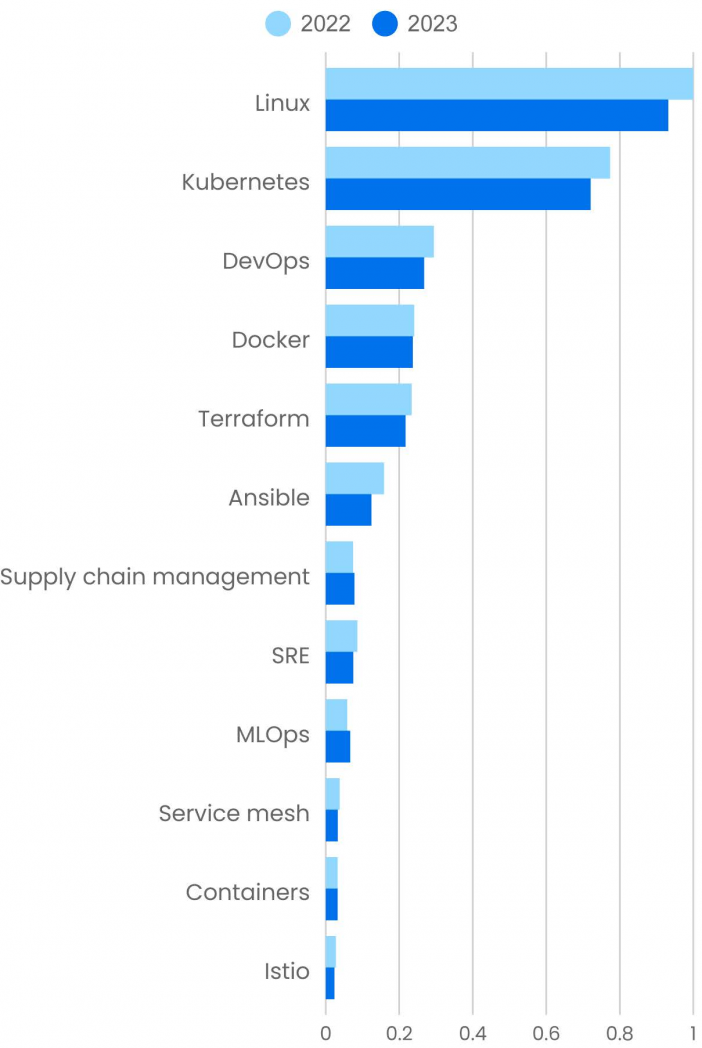
DevOps (9.0%) and SRE (13%) are additionally down, although we don’t suppose that’s vital. Phrases come and go, and these are going. Whereas operations is consistently evolving, we don’t imagine we’ll ever get to the legendary state of “NoOps,” nor ought to we. As an alternative, we’ll see fixed evolution because the ratio of methods managed to operations employees grows ever larger. However we do imagine that sooner relatively than later, somebody will put a brand new identify on the disciplines of DevOps and its shut relative, SRE. That new identify may be “platform engineering,” although that time period says extra about designing deployment pipelines than about carrying the pager and retaining the methods operating; platform engineering is about treating builders as prospects and designing inside developer platforms that make it simple to check and deploy software program methods with minimal ceremony. We don’t imagine that platform engineering subsumes or replaces DevOps. Each are companions in enhancing expertise for builders and operations employees (and ratcheting up the ratio of methods managed to employees even larger).
That’s a whole lot of pink ink. What’s within the black? Provide chain administration is up 5.9%. That’s not an enormous improve, however up to now few years we’ve been compelled to consider how we handle the software program provide chain. Any vital utility simply has dozens of dependencies, and every of these dependencies has its personal dependencies. The entire variety of dependencies, together with each direct and inherited dependencies, can simply be tons of and even hundreds. Malicious operators have found that they will corrupt software program archives, getting programmers to inadvertently incorporate malware into their software program. Sadly, safety issues by no means actually go away; we anticipate software program provide chain safety to stay an essential difficulty for the foreseeable (and unforeseeable) future.
We’ve already talked about that MLOps, the self-discipline of deploying and managing fashions for machine studying and synthetic intelligence, is up 14%. Machine studying and AI characterize a brand new type of software program that doesn’t observe conventional guidelines, so conventional approaches to operations don’t work. The record of variations is lengthy:
- Whereas most approaches to deployment are primarily based on the concept an utility will be reproduced from a supply archive, that isn’t true for AI. An AI system relies upon as a lot on the coaching information because it does on the supply code, and we don’t but have good instruments for archiving coaching information.
- Whereas we’ve stated that open supply fashions reminiscent of Alpaca are a lot smaller than fashions like GPT-4 or Google’s Gemini, even the smallest of these fashions could be very giant by any affordable normal.
- Whereas we’ve gotten used to automated testing as a part of a deployment pipeline, AI fashions aren’t deterministic. A check doesn’t essentially give the identical end result each time it runs. Testing is not any much less essential for AI than it’s for conventional software program (arguably it’s extra essential), and we’re beginning to see startups constructed round AI testing, however we’re nonetheless at first.
That’s only a begin. MLOps is a badly wanted specialty. It’s good to see rising curiosity.
Safety
Virtually all branches of safety confirmed development from 2022 to 2023. That’s a welcome change: within the current previous, many firms talked about safety however by no means made the funding wanted to safe their methods. That’s altering, for causes which can be apparent to anybody who reads the information. No one needs to be a sufferer of knowledge theft or ransomware, significantly now that ransomware has developed into blackmail.
The challenges are actually quite simple. Community safety, retaining intruders off of your community, was probably the most extensively used subject and grew 5%. Firewalls, that are an essential element of community safety, grew 16%. Hardening, a a lot smaller subject that addresses making methods much less weak to assault, grew 110%. Penetration testing remained one of the crucial extensively used subjects. Utilization dropped 5%, though a ten% improve for Kali Linux (an essential instrument for penetration testers) largely offsets that decline.
The 22% development in safety governance is one other indicator of modified attitudes: safety is not an advert hoc train that waits for one thing to occur after which fights fires. Safety requires planning, coaching, testing, and auditing to make sure that insurance policies are efficient.
One key to safety is figuring out who your customers are and which elements of the system every person can entry. Identification and entry administration (IAM) has usually been recognized as a weak point, significantly for cloud safety. As methods develop extra advanced, and as our idea of “id” evolves from people to roles assigned to software program providers, IAM turns into rather more than usernames and passwords. It requires an intensive understanding of who the actors are in your methods and what they’re allowed to do. This extends the outdated concept of “least privilege”: every actor wants the flexibility to do precisely what they want, no extra and no much less. Using content material about IAM grew 8.0% up to now 12 months. It’s a smaller acquire than we’d have favored to see however not insignificant.
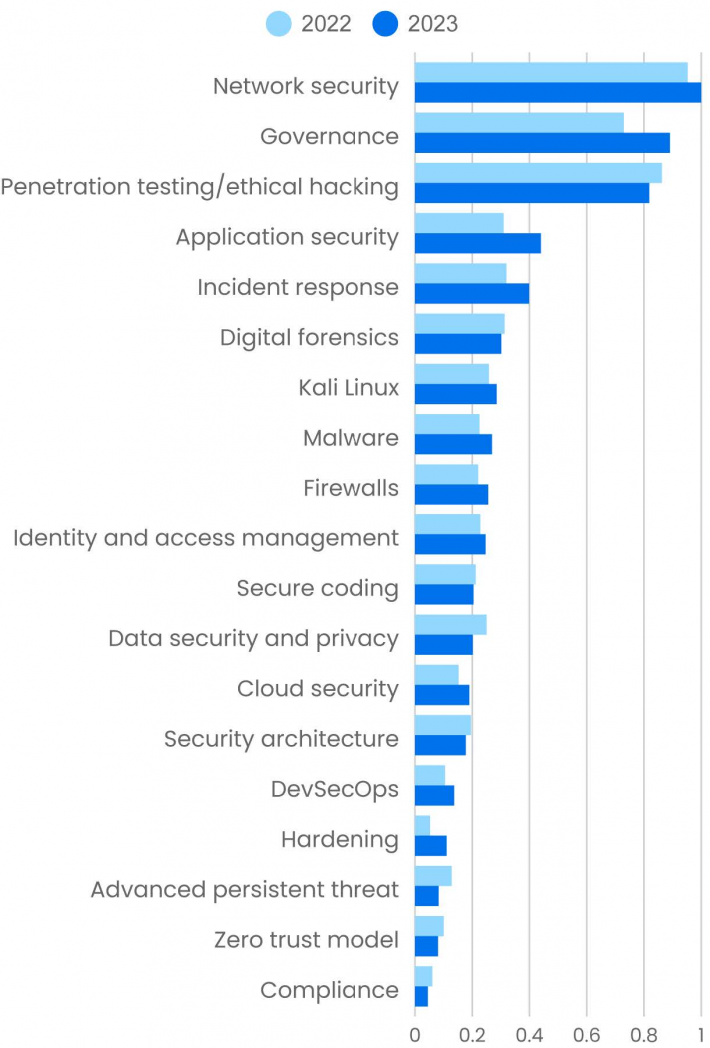
Software safety grew 42%, exhibiting that software program builders and operations employees are getting the message. The DevSecOps “shift left” motion, which focuses on software program safety early within the growth course of, seems to be profitable; use of content material about DevSecOps was up 30%. Equally, those that deploy and keep purposes have turn out to be much more conscious of their tasks. Builders might design id and entry administration into the code, however operations is answerable for configuring these accurately and making certain that entry to purposes is just granted appropriately. Safety can’t be added after the actual fact; it needs to be a part of the software program course of from starting to the top.
Superior persistent threats (APTs) have been all around the information a couple of years in the past. We don’t see the time period APT anyplace close to as a lot as we used to, so we’re not stunned that utilization has dropped by 35%. However, nation-states with subtle offensive capabilities are very actual, and cyber warfare is a crucial element of a number of worldwide conflicts, together with the warfare in Ukraine.
It’s disappointing to see that utilization of content material about zero belief has declined by 20%. That lower is greater than offset by the rise in IAM, which is a vital instrument for zero belief. However don’t neglect that IAM is only a instrument and that the objective is to construct methods that don’t depend on belief, that at all times confirm that each actor is appropriately recognized and approved. How are you going to defend your IT infrastructure when you assume that attackers have already got entry? That’s the query zero belief solutions. Belief nothing; confirm every little thing.
Lastly, compliance is down 27%. That’s greater than offset by the substantial improve of curiosity in governance. Auditing for compliance is definitely part of governance. Specializing in compliance itself, with out making an allowance for the bigger image, is an issue relatively than an answer. We’ve seen many firms that target compliance with present requirements and laws whereas avoiding the exhausting work of analyzing danger and creating efficient insurance policies for safety. “It isn’t our fault that one thing unhealthy occurred; we adopted all the principles” is, at greatest, a poor strategy to clarify systemic failure. If that compliance-oriented mindset is fading, good riddance. Compliance, understood correctly, is a crucial element of IT governance. Understood badly, compliance is an unacceptable excuse.
Lastly, a phrase a few subject that doesn’t but seem in our information. There has, in fact, been a whole lot of chatter about the usage of AI in safety purposes. AI might be an amazing asset for log file evaluation, intrusion detection, incident response, digital forensics, and different features of cybersecurity. However, as we’ve already stated, there are at all times two sides to AI. How does AI change safety itself? Any group with AI purposes must shield them from exploitation. What vulnerabilities does AI introduce that didn’t exist a couple of years in the past? There are a lot of articles about immediate injection, sneaky prompts designed to “jailbreak” AI methods, information leakage, and different vulnerabilities—and we imagine that’s solely the start. Securing AI methods might be a essential subject within the coming years.
Cloud Computing
platform utilization for cloud-related subjects, one factor stands out: cloud native. Not solely is it probably the most extensively used subject in 2023, however it grew 175% from 2022 to 2023. This marks an actual transition. Previously, firms constructed software program to run on-premises after which moved it to the cloud as mandatory. Regardless of stories (together with ours) that confirmed 90% or extra “cloud adoption,” we at all times felt that was very optimistic. Positive, 90% of all firms might have one or two experiments in the cloud—however are they actually constructing for the cloud? This large surge in cloud native growth reveals that we’ve now crossed that chasm and that firms have stopped kicking the tires. They’re constructing for the cloud as their major deployment platform.
You would, in fact, draw the other conclusion by taking a look at cloud deployment, which is down 27%. If firms are creating for the cloud, how are these purposes being deployed? That’s a good query. Nevertheless, as cloud utilization grows, so does organizational information of cloud-related subjects, significantly deployment. As soon as an IT group has deployed its first utility, the second isn’t essentially “simple” or “the identical,” however it’s acquainted. At this level within the historical past of cloud computing, we’re seeing few full newcomers. As an alternative we’re seeing present cloud customers deploying an increasing number of purposes. We’re additionally seeing an increase in instruments that streamline cloud deployment. Certainly, any supplier price serious about has an incredible curiosity in making deployment so simple as potential.
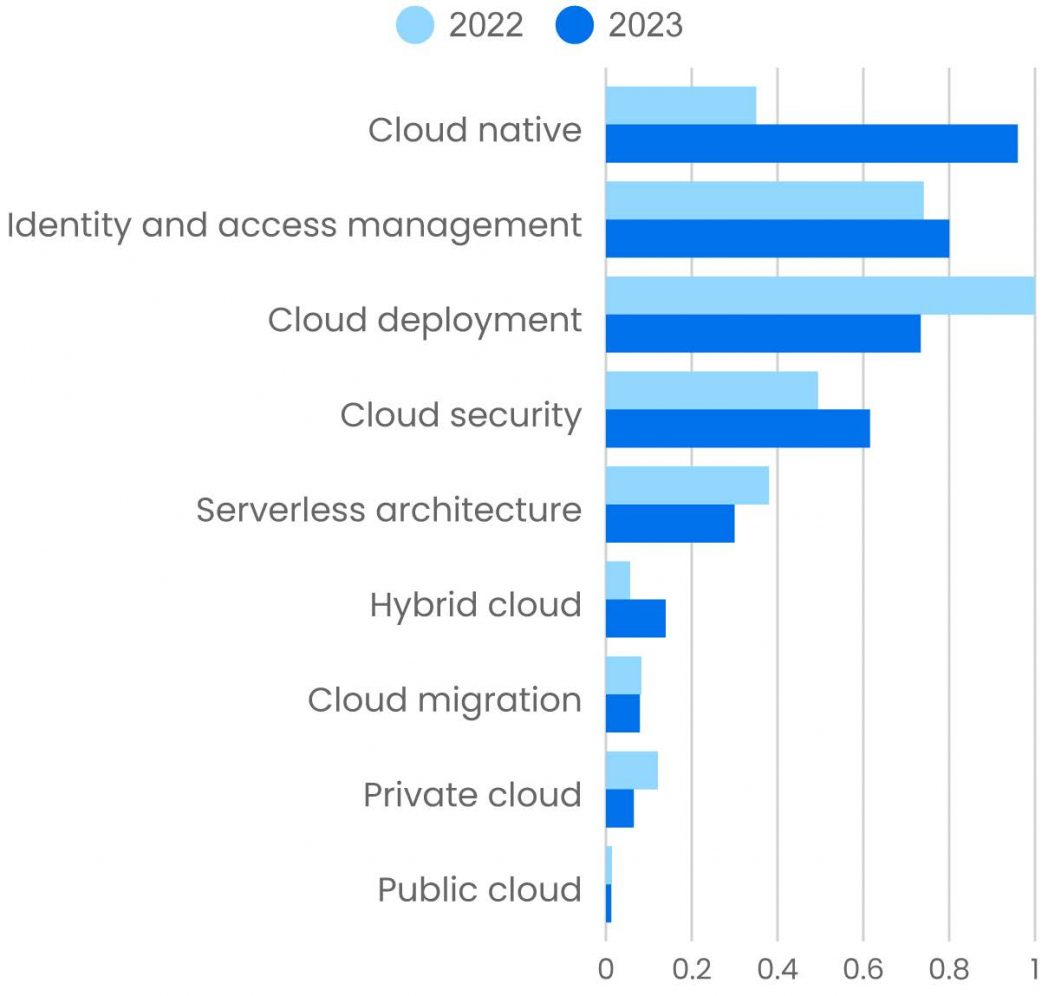
Use of content material about cloud safety grew 25%, and id and entry administration (IAM) grew 8%. An epidemic of knowledge theft and ransomware that continues to today put safety on the company map as a precedence, not simply an expense with annual funds requests that seemed like an extortion rip-off: “Nothing unhealthy occurred this 12 months; give us more cash and possibly nothing unhealthy will occur subsequent 12 months.” And whereas the inspiration of any safety coverage is sweet native safety hygiene, it’s additionally true that the cloud presents its personal points. Identification and entry administration: domestically, which means passwords, key playing cards, and (most likely) two-factor authentication. Within the cloud, which means IAM, together with zero belief. Identical concept, however it could be irresponsible to suppose that these aren’t tougher within the cloud.
Hybrid cloud is a smaller subject space that has grown considerably up to now 12 months (145%). This development factors partly to the cloud changing into the de facto deployment platform for enterprise purposes. It additionally acknowledges the truth of how cloud computing is adopted. Years in the past, when “the cloud” was getting began, it was simple for a couple of builders in R&D to expense a couple of hours of time on AWS relatively than requisitioning new {hardware}. The identical was true for data-aware entrepreneurs who wished to investigate what was taking place with their potential prospects—and so they would possibly select Azure. When senior administration lastly awoke to the necessity for a “cloud technique,” they have been already in a hybrid state of affairs, with a number of wildcat initiatives in a number of clouds. Mergers and buyouts sophisticated the state of affairs extra. If firm A is primarily utilizing AWS and firm B has invested closely in Google Cloud, what occurs after they merge? Unifying behind a single cloud supplier isn’t going to be price it, though cloud suppliers are offering instruments to simplify migration (similtaneously they make their very own clouds tough to depart). The cloud is of course hybrid. “Personal cloud” and “public cloud,” when positioned as alternate options to one another and to a hybrid cloud, scent like “final 12 months’s information.” It’s not stunning that utilization has dropped 46% and 10%, respectively.
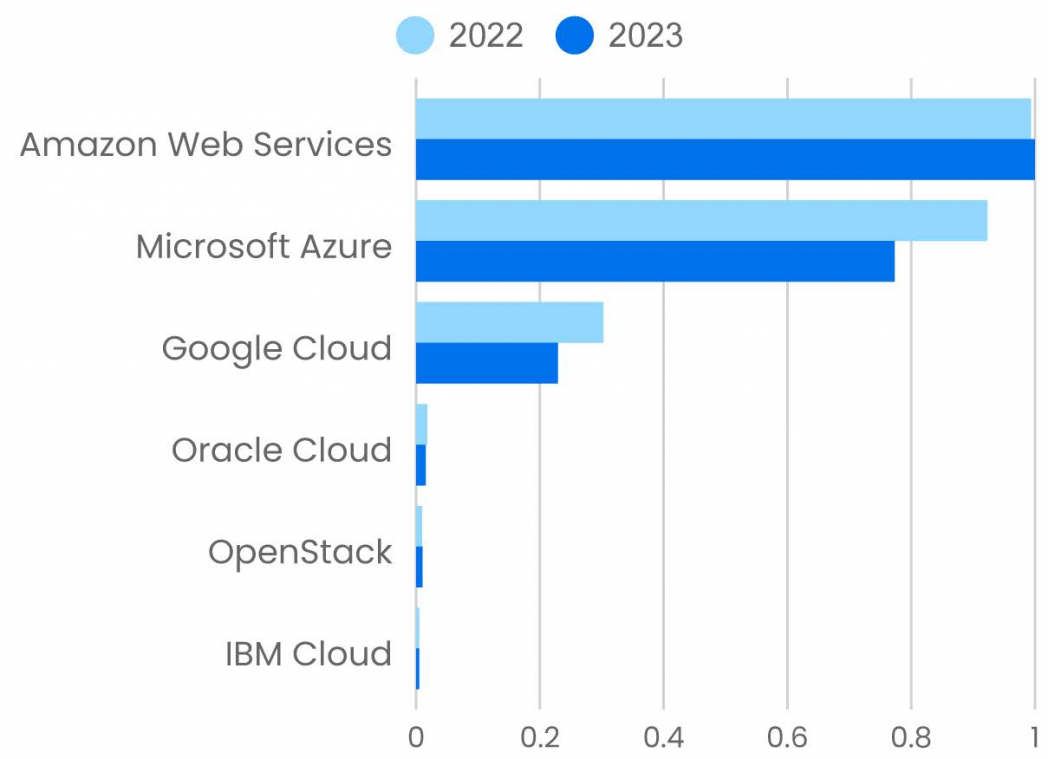
What concerning the perennial horse race between Amazon Internet Providers, Microsoft Azure, and Google Cloud? Is anybody nonetheless , besides maybe buyers and analysts? AWS confirmed a really, very small acquire (0.65%), however Azure and Google Cloud confirmed vital losses (16% and 22%, respectively). We anticipated to see Azure catch as much as AWS due to its lead in AI as a service, however it didn’t. So far as our platform is worried, that’s nonetheless sooner or later.
Internet Growth
React and Angular proceed to dominate net growth. JavaScript continues to be the lingua franca of net growth, and that isn’t prone to change any time quickly.
However the utilization sample has modified barely. Final 12 months, React was up, and Angular was sharply down. This 12 months, utilization of React content material hasn’t modified considerably (down 0.33%). Angular is down 12%, a smaller decline than final 12 months however nonetheless vital. When a platform is as dominant as React, it could have nowhere to go however down. Is momentum shifting?
We see some attention-grabbing adjustments among the many much less common frameworks, each outdated and new. First, Vue isn’t a big a part of the general image, and it isn’t new—it’s been round since 2014—but when its 28% annual development continues, it’s going to quickly turn out to be a dominant framework. That improve represents a stable turnaround after dropping 17% from 2021 to 2022. Django is even older (created in 2005), however it’s nonetheless extensively used—and with an 8% improve this 12 months, it’s not going away. FastAPI is the most recent of this group (2018). Although it accounts for a really small share of platform use, it’s simple for a small change in utilization to have an enormous impact. An 80% improve is tough to disregard.
It’s price taking a look at these frameworks in just a little extra element. Django and FastAPI are each Python-based, and FastAPI takes full benefit of Python’s sort hinting function. Python has lengthy been an also-ran in net growth, which has been dominated by JavaScript, React, and Angular. Might that be altering? It’s exhausting to say, and it’s price noting that Flask, one other Python framework, confirmed a 12% lower. As a complete, Python frameworks most likely declined from 2022 to 2023, however that might not be the top of the story. Given the variety of boot camps coaching new net programmers in React, the JavaScript hegemony might be exhausting to beat.
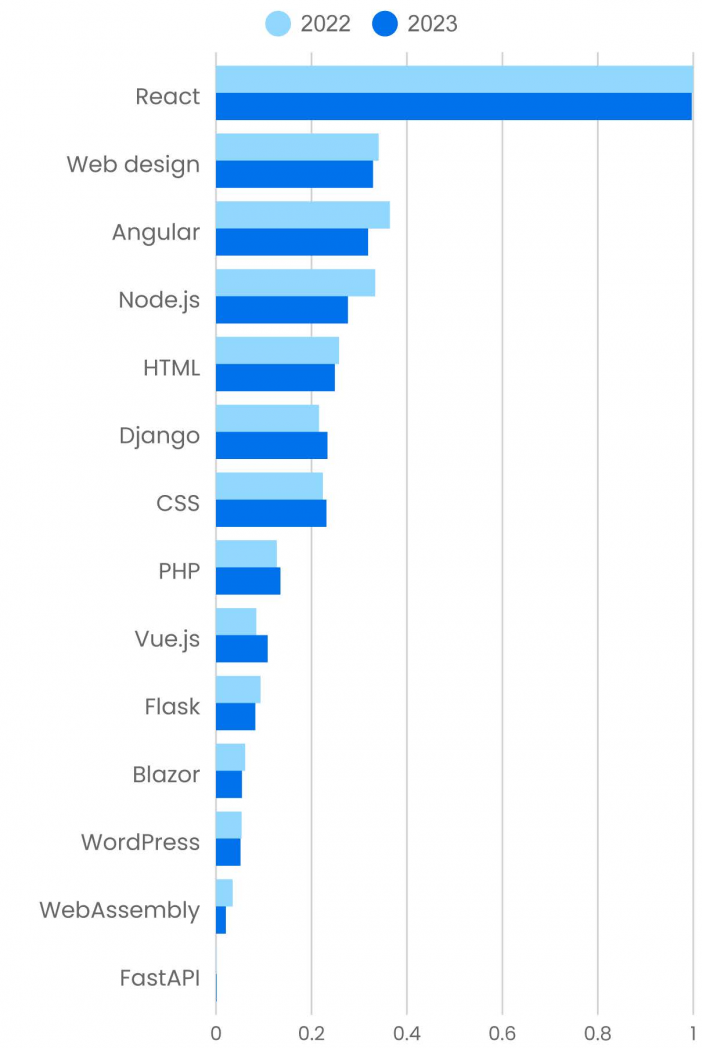
What about PHP, one other long-standing framework that dates again to 1995, when the online was certainly younger? PHP grew 5.9% up to now 12 months. Using content material about PHP is small in comparison with frameworks like React and Angular and even Django. PHP definitely doesn’t encourage the joy that it did within the Nineties. However keep in mind that over 80% of the online is constructed on PHP. It’s definitely not stylish, it’s not able to constructing the feature-rich websites that many customers anticipate—however it’s all over the place. WordPress (down 4.8%), a content material administration system used for tens of millions of internet sites, is predicated on PHP. However whatever the variety of websites which can be constructed on PHP or WordPress, Certainly reveals roughly thrice as many job openings for React builders as for PHP and WordPress mixed. PHP definitely isn’t going away, and it could even be rising barely. However we suspect that PHP programmers spend most of their time sustaining older websites. They already know what they want to do this, and neither of these components drives content material utilization.
What about another extremely buzzworthy applied sciences? After exhibiting 74% development from 2021 to 2022, WebAssembly (Wasm) declined by 41% in 2023. Blazor, an online framework for C# that generates code for Wasm, declined by 11%. Does that imply that Wasm is dying? We nonetheless imagine Wasm is an important expertise, and we steadily examine wonderful initiatives which can be constructed with it. It isn’t but a mature expertise—and there are many builders keen to argue that there’s no want for it. We might disagree, however that misses the purpose. Utilization of Wasm content material will most likely decline steadily…till somebody creates a killer utility with it. Will that occur? Most likely, however we are able to’t guess when.
What does this imply for somebody who’s making an attempt to develop their abilities as an online developer? First, you continue to can’t go fallacious with React, and even with Angular. The opposite JavaScript frameworks, reminiscent of Subsequent.js, are additionally good choices. Many of those are metaframeworks constructed on React, so figuring out them makes you extra versatile whereas leveraging information you have already got. In the event you’re trying to broaden your abilities, Django could be a worthwhile addition. It’s a really succesful framework, and figuring out Python will open up different potentialities in software program growth which may be useful sooner or later, even when not now.
Certification
This 12 months, we took a distinct strategy to certification. Slightly than discussing certification for various topic areas individually (that’s, cloud certification, safety certification, and so on.), we used information from the platform to construct an inventory of the highest 20 certifications and grouped them collectively. That course of offers a barely totally different image of which certifications are essential and why. We additionally took a quick have a look at O’Reilly’s new badges program, which provides one other perspective on what our prospects wish to study.
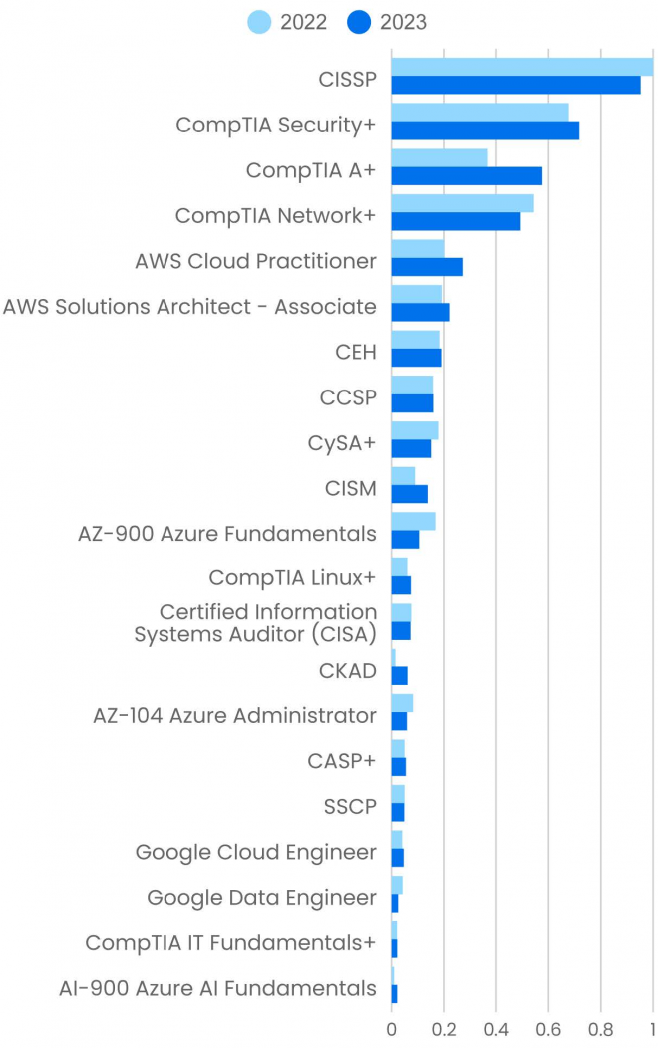
Based mostly on the utilization of content material in our platform (together with observe assessments), the preferred certifications are safety certifications: CISSP (which declined 4.8%) and CompTIA Safety+ (which grew 6.0%). CISSP is an in-depth examination for safety professionals, requiring not less than 5 years’ expertise earlier than taking the examination. Safety+ is extra of an entry-level examination, and its development reveals that safety employees are nonetheless in demand. ISACA’s Licensed Info Safety Supervisor (CISM) examination, which focuses on danger evaluation, governance, and incident response, isn’t as common however confirmed a 54% improve. CompTIA’s Licensed Superior Safety Practitioner (CASP+) confirmed a ten% improve—not as giant however a part of the identical development. The Licensed Moral Hacker (CEH) examination, which focuses on strategies helpful for penetration testing or red-teaming, is up 4.1%, after a decline final 12 months. These will increase replicate the place administration is investing. Hoping that there gained’t be an incident has been changed by understanding publicity, putting in governance mechanisms to attenuate danger, and having the ability to reply to incidents after they happen.
What actually stands out, nonetheless, isn’t safety: it’s the elevated use of content material about CompTIA A+, which is up 58%. A+ isn’t a safety examination; it’s marketed as an entry-level examination for IT assist, stressing subjects like working methods, managing SaaS for distant work, troubleshooting software program, {hardware}, and networking issues, and the like. It’s testimony to the big quantity of people that wish to get into IT. Utilization of content material concerning the CompTIA Linux+ examination was a lot decrease but in addition grew sharply (23%)—and, as we’ve stated up to now, Linux is “desk stakes” for nearly any job in computing. It’s extra probably that you just’ll encounter Linux not directly by way of containers or cloud suppliers relatively than managing racks of computer systems operating Linux; however you’ll be anticipated to understand it. The Licensed Kubernetes Administrator (CKAD) examination additionally confirmed vital development (32%). Because it was first launched in 2014, Kubernetes has turn out to be an inescapable a part of IT operations. The largest development in IT, going again 70 years or so, has been the rise within the ratio of machines to operators: from a number of operators per machine within the ’60s to at least one operator per machine within the period of minicomputers to dozens and now, within the cloud, to tons of and hundreds. Advanced as Kubernetes is—and we admit, we maintain on the lookout for a less complicated various—it’s what lets IT teams handle giant purposes which can be applied as dozens of microservices and that run in hundreds of containers on an uncountable variety of digital machines. Kubernetes has turn out to be a vital ability for IT. And certification is changing into more and more enticing to individuals working within the discipline; there’s no different space wherein we see a lot development.
Cloud certifications additionally present prominently. Though “the cloud” has been round for nearly 20 years, and virtually each firm will say that they’re “within the cloud,” in actuality many firms are nonetheless making that transition. Moreover, cloud suppliers are consistently including new providers; it’s a discipline the place maintaining with change is tough. Content material about Amazon Internet Providers was most generally used. AWS Cloud Practitioner elevated by 35%, adopted by AWS Options Architect (Affiliate), which elevated 15%. Microsoft Azure certification content material adopted, although the 2 most distinguished exams confirmed a decline: Azure Fundamentals (AZ-900) was down 37%, and Azure Administration (AZ-104) was down 28%. Google Cloud certifications trailed the remaining: Google’s Cloud Engineer confirmed stable development (14%), whereas its Knowledge Engineer confirmed a major decline (40%).
Content material about Microsoft’s AI-900 examination (Azure AI Fundamentals) was the least-used among the many certifications that we tracked. Nevertheless, it gained 121%—it greater than doubled—from 2022 to 2023. Whereas we are able to’t predict subsequent 12 months, that is the form of change that tendencies are manufactured from. Why did this examination instantly get so scorching? It’s simple, actually: Microsoft’s funding in OpenAI, its integration of the GPT fashions into Bing and different merchandise, and its AI-as-a-service choices by Azure have instantly made the corporate a pacesetter in cloud-based AI. Whereas we usually hedge our bets on smaller subjects with massive annual development—it’s simple for a single new course or e book to trigger a big swing—AI isn’t going away, neither is Microsoft’s management in cloud providers for AI builders.
Late in 2023, O’Reilly started to supply badges tied to course completion on the O’Reilly studying platform. Badges aren’t certifications, however trying on the high badges offers one other tackle what our prospects are fascinated about studying. The outcomes aren’t stunning: Python, GPT (not simply ChatGPT), Kubernetes, software program structure, and Java are the preferred badges.
Nevertheless, it’s attention-grabbing to take a look at the distinction between our B2C prospects (prospects who’ve purchased platform subscriptions as people) and B2B prospects (who use the platform by way of a company subscription). For many subjects, together with these listed above, the ratio of B2B to B2C prospects is within the vary of two:1 or 3:1 (two or thrice as many company prospects as people). The outliers are for subjects like communications abilities, Agile, Scrum, private productiveness, Excel, and presentation abilities: customers from B2B accounts obtained these badges 4 (or extra) instances as usually as customers with private accounts. This is smart: these subjects are about teamwork and different abilities which can be useful in a company atmosphere.
There are few (if any) badge subjects for which particular person (B2C) customers outnumbered company prospects; that’s only a reflection of our buyer base. Nevertheless, there have been some subjects the place the ratio of B2B to B2C prospects was nearer to at least one. Probably the most attention-grabbing of those involved synthetic intelligence: giant language fashions (LLMs), TensorFlow, pure language processing, LangChain, and MLOps. Why is there extra curiosity amongst people than amongst company prospects? Maybe by subsequent 12 months we’ll know.
Design
The essential story in design is about instruments. Matters like person expertise and net design are steady or barely down (down 0.62% and three.5%, respectively). However utilization about design instruments is up 105%, and the VC unicorn Figma is up 145%. Triple-digit development most likely gained’t proceed, however it’s definitely price noticing. It highlights two essential tendencies that transcend typical design subjects, like UX.
First, low-code and no-code instruments aren’t new, however many new ones have appeared up to now 12 months. Their success has been aided by synthetic intelligence. We have already got AI instruments that may generate textual content, whether or not for a manufacturing website or for a mockup. Quickly we’ll have no-code instruments that don’t simply spit out a wireframe however will have the ability to implement the design itself. They are going to be good about what the person needs them to do. However to know the significance of low-code to design, you need to look past the use designers will make of those instruments. Designers will even be designing these instruments, together with different AI-powered purposes. Instruments for designers need to be well-designed, in fact: that’s trivial. However what many discussions about AI ignore is that designing purposes that use AI nicely is much from trivial. We’ve all been blindsided by the success of ChatGPT, which made the GPT fashions immediately accessible to everybody. However when you begin serious about the probabilities, you notice {that a} chat is hardly an excellent interface for an AI system.2 What’s going to the customers of those methods actually need? We’ve solely simply began down that path. Will probably be an thrilling journey—significantly for designers.
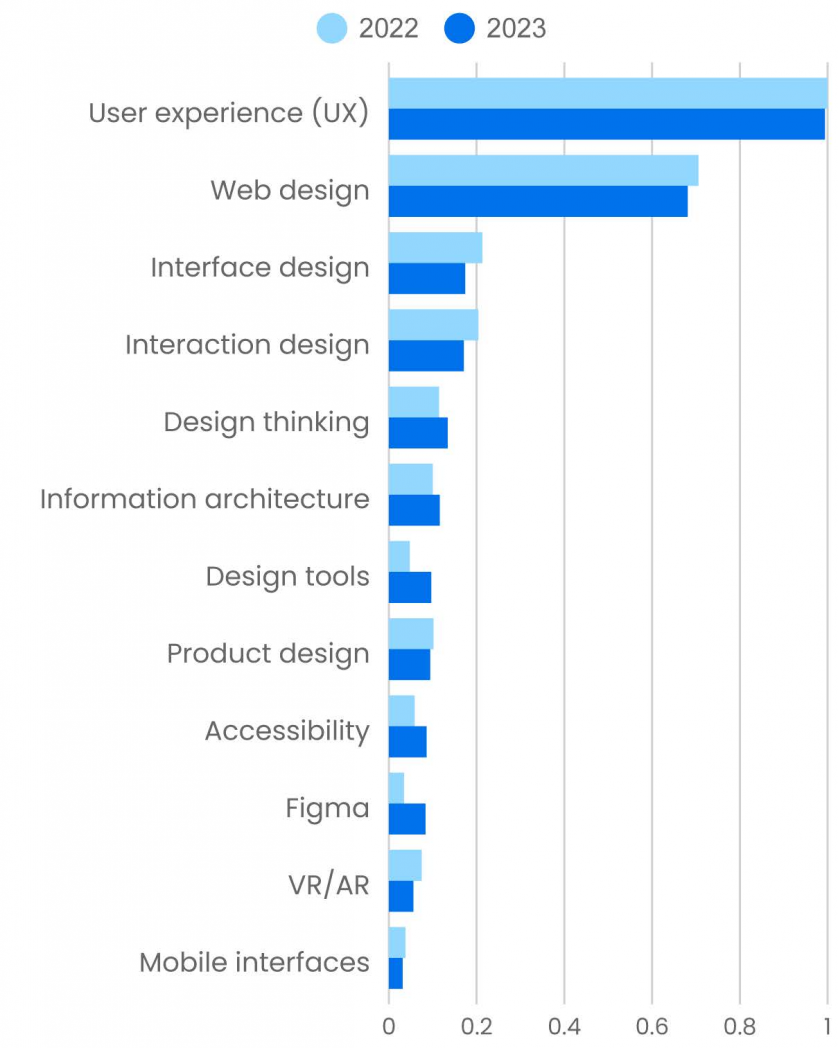
Second, Figma is essential as a result of it’s a breakthrough in instruments for collaboration. Instruments that permit distant workers to collaborate productively are essential when coworkers will be anyplace: in an workplace, at house, or on one other continent. The final 12 months and a half has been stuffed with discuss digital actuality, metaverses, and the like. However what few have realized is that the metaverse isn’t about carrying goggles—it’s about seamless collaboration with pals and coworkers. Use of content material about AR and VR dropped 25% as a result of individuals have missed the actual story: we don’t want 3D goggles; we’d like instruments for collaboration. And, as with low-code, collaboration instruments are each one thing to design with and one thing that must be designed. We’re on the sting of a brand new manner to take a look at the world.
Use of content material about info structure was up 16%, recovering from its decline from 2021 to 2022. The necessity to current info nicely, to design the environments wherein we devour info on-line, has by no means been extra essential. Daily, there’s extra info to soak up and to navigate—and whereas synthetic intelligence will little question assist with that navigation, AI is as a lot a design drawback as a design answer. (Although it’s a “good drawback” to have.) Designing and constructing for accessibility is clearly associated to info structure, and it’s good to see extra engagement with that content material (up 47%). It’s been a very long time coming, and whereas there’s nonetheless a protracted strategy to go, accessibility is being taken extra severely now than up to now. Web sites which can be designed to be usable by individuals with impairments aren’t but the rule, however they’re not exceptions.
Skilled Growth
Virtually everybody concerned with software program begins as a programmer. However that’s not often the place they finish. In some unspecified time in the future of their profession, they’re requested to put in writing a specification, lead a group, handle a bunch, or possibly even discovered an organization or function an government in an present firm.
O’Reilly is the final firm to imagine that software program builders are neck-bearded geeks who need nothing greater than to stay in a cave and kind on their terminals. We’ve spent most of our historical past preventing in opposition to that stereotype. However, going past software program growth is a frequent supply of hysteria. That’s little question true for anybody stepping exterior their consolation zone in nearly any discipline, whether or not it’s accounting, legislation, drugs, or one thing else. However sooner or later in your profession, you need to do one thing that you just aren’t ready to do. And, actually, the very best leaders are often those who’ve some anxiousness, not those whose response is “I used to be born to be a pacesetter.”
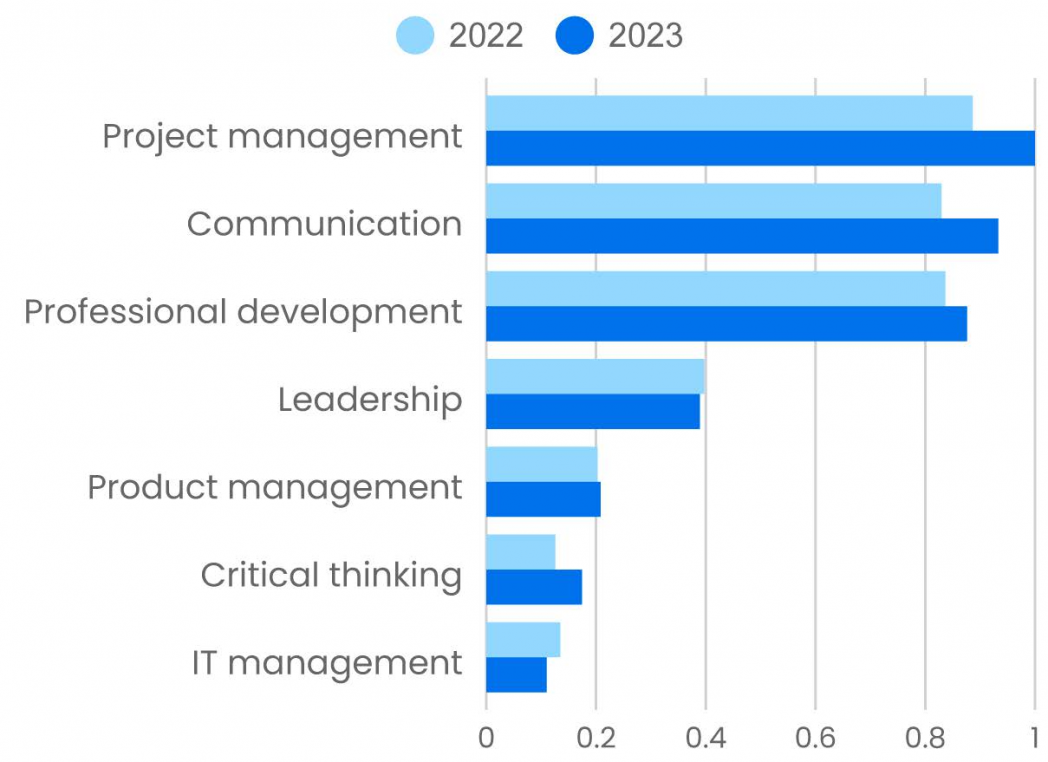
For the previous few years, our viewers has been fascinated about skilled development that goes past simply writing software program or constructing fashions for AI and ML. Challenge administration is up 13%; the flexibility to handle giant initiatives is clearly seen as an asset for workers who’re on the lookout for their subsequent promotion (or, in some instances, their subsequent job). No matter their objectives may be, anybody on the lookout for a promotion or a brand new job—and even simply solidifying their maintain on their present job—could be nicely served by enhancing their communications abilities (up 23%). Skilled growth (up 22%) is a catch-all subject that seems to be responding to the identical wants. What’s driving this? 2023 started and ended with a whole lot of information about layoffs. However regardless of well-publicized layoffs from large firms that overhired in the course of the pandemic, there’s little proof that the trade as a complete has suffered. People who find themselves laid off appear to be snapped up rapidly by new employers. However, anxiousness is actual, and the emphasis we’re seeing on skilled growth (and particularly, communications and undertaking administration abilities) is partially a results of that anxiousness. One other a part of the story is little question the way in which AI is altering the office. If generative AI makes individuals extra environment friendly, it frees up time for them to do different issues, together with strategic serious about product growth and management. It might lastly be time to worth “people and interactions over processes and instruments,” and “buyer collaboration over contract negotiation,” because the Agile Manifesto claims. Doing so would require a certain quantity of reeducation, specializing in areas like communications, interpersonal abilities, and strategic considering.
Product administration, the self-discipline of managing a product’s lifecycle from the preliminary concept by growth and launch to the market, can also be a fascinating ability. So why is it solely up 2.8% and never 20% like undertaking administration? Product administration is a more moderen place in most firms; it has robust ties to advertising and marketing and gross sales, and so far as concern of layoffs is worried (whether or not actual or media pushed), product administration positions could also be perceived as extra weak.
A have a look at the underside of the chart reveals that utilization of content material that teaches essential considering grew 39%. That might be partly a consequence of ChatGPT and the explosion in synthetic intelligence. Everybody is aware of that AI methods make errors, and virtually each article that discusses these errors talks concerning the want for essential considering to investigate AI’s output and discover errors. Is that the trigger? Or is the need for higher essential considering abilities simply one other side {of professional} development?
A Unusual Yr?
Again at the beginning, I stated this was an odd 12 months. As a lot as we like to speak concerning the pace at which expertise strikes, actuality often doesn’t transfer that quick. When did we first begin speaking about information? Tim O’Reilly stated “Knowledge is the following Intel Inside” in 2005, virtually 20 years in the past. Kubernetes has been round for a decade, and that’s not counting its prehistory as Google’s Borg. Java was launched in 1995, virtually 30 years in the past, and that’s not counting its set-top field prehistory as Oak and Inexperienced. C++ first appeared in 1985. Synthetic intelligence has a prehistory so long as computing itself. When did AI emerge from its wintry cave to dominate the info science panorama? 2016 or 2017, once we have been amazed by applications that would kind photos into canine and cats? Positive, Java has modified loads; so has what we do with information. Nonetheless, there’s extra continuity than disruption.
This 12 months was one of many few years that would genuinely be referred to as disruptive. Generative AI will change this trade in essential methods. Programmers gained’t turn out to be out of date, however programming as we all know it’d. Programming may have extra to do with understanding issues and designing good options than specifying, step-by-step, what a pc must do. We’re not there but, however we are able to definitely think about a day when a human language description leads reliably to working code, when “Do what I meant, not what I stated” ceases to be the programmer’s curse. That change has already begun, with instruments like GitHub Copilot. However to thrive in that new trade, programmers might want to know extra about structure, extra about design, extra about human relations—and we’re solely beginning to see that in our information, primarily for subjects like product administration and communications abilities. And maybe that’s the definition of “disruptive”: when our methods and our expectations change sooner than our potential to maintain up. I’m not nervous about programmers “dropping their jobs to an AI,” and I actually don’t see that concern among the many many programmers I speak to. However no matter career you’re in, you’ll lose out when you don’t sustain. That isn’t variety or humane; that’s capitalism. And maybe I ought to have used ChatGPT to put in writing this report.3
Jerry Lee Lewis might need stated “There’s a complete lotta disruption goin’ on.” However regardless of all this disruption, a lot of the trade stays unchanged. Individuals appear to have bored with the phrases DevOps and SRE, however so it goes: the half-life of a buzzword is inevitably quick, and these have been terribly long-lived. The issues these buzzwords characterize haven’t gone away. Though we aren’t but accumulating the info (and don’t but have sufficient content material for which to gather information), developer platforms, self-service deployment, and platform engineering appear like the following step within the evolution of IT operations. Will AI play a job in platform engineering? We’d be stunned if it didn’t.
Motion to the cloud continues. Whereas we’ve heard speak of cloud “repatriation,” we see no proof that it’s taking place. We do see proof that organizations notice that the cloud is of course hybrid and that specializing in a single cloud supplier is short-sighted. There’s additionally proof that organizations are actually paying greater than lip service to safety, significantly cloud safety. That’s an excellent signal, particularly after a few years wherein firms approached safety by hoping nothing unhealthy would occur. As many chess grandmasters have stated, “Hope is rarely technique.”
Within the coming 12 months, AI’s disruption will proceed to play out. What penalties will it have for programming? How will jobs (and job prospects) change? How will IT adapt to the problem of managing AI purposes? Will they depend on AI-as-a-service suppliers like OpenAI, Azure, and Google, or will they construct on open supply fashions, which can most likely run within the cloud? What new vulnerabilities will AI purposes introduce into the safety panorama? Will we see new architectural patterns and kinds? Will AI instruments for software program structure and design assist builders grapple with the difficulties of microservices, or will it simply create confusion?
In 2024, we’ll face all of those questions. Maybe we’ll begin to see solutions. One factor is obvious: it’s going to be an thrilling 12 months.
Footnotes
- Google Traits suggests that we could also be seeing a resurgence in ChatGPT searches. In the meantime, searches for ChatGPT on our platform seem to have bottomed out in October, with a really slight improve in November. This discrepancy aligns nicely with the distinction between our platform and Google’s. If you wish to use ChatGPT to put in writing a time period paper, are you going to go looking Google or O’Reilly?
- Phillip Carter’s article, “All of the Laborious Stuff No one Talks About when Constructing Merchandise with LLMs,” is price studying. Whereas it isn’t particularly about design, virtually every little thing he discusses is one thing designers ought to take into consideration.
- I didn’t. Not even for information evaluation.
